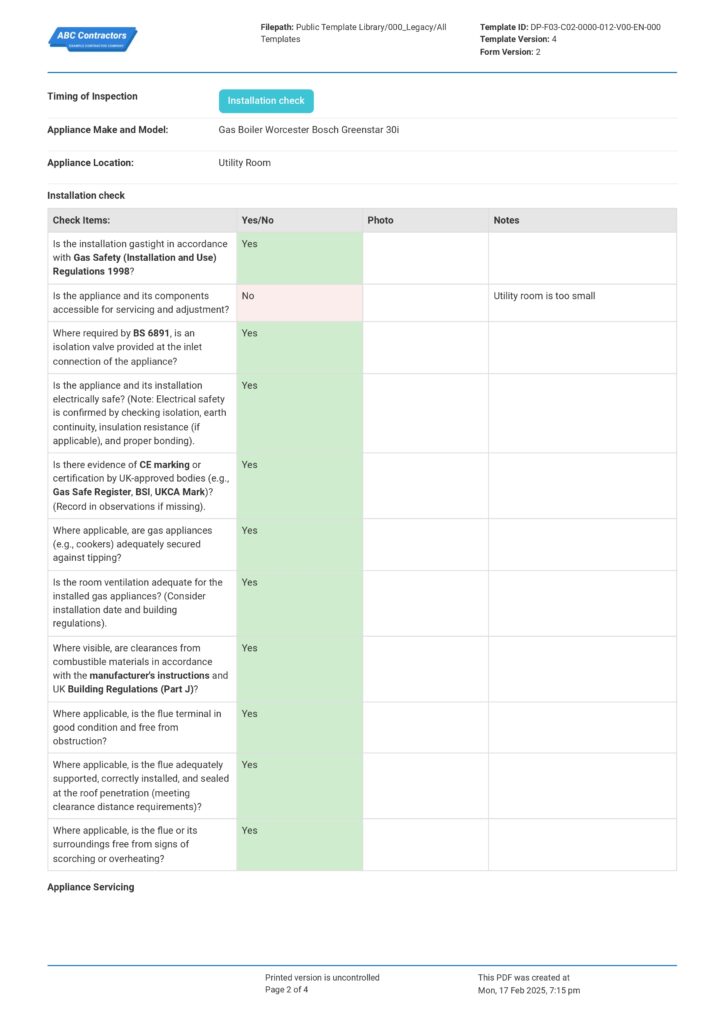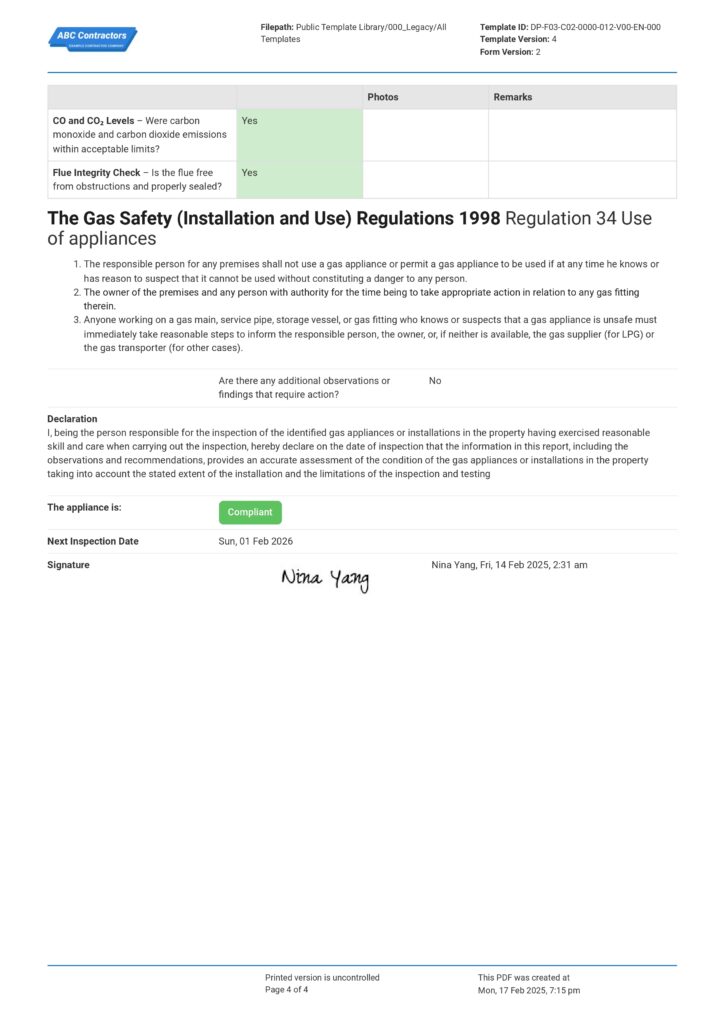Article Page – Gas Safety Check
Gas Safety Check
This gas safety check article is a comprehensive guide for companies needing to conduct gas safety checks, covering what gas safety checks involve, your legal requirements, and providing you with a number of free resources you can use for your own safety checks.

What is a Gas safety check?
A Gas Safety Check is an inspection of gas appliances like cookers, ovens, or boilers to make sure they are working properly for the safety of the people within the residential or commercial building as well as the neighbouring area. Gas safety checks are needed by landlords, commercial establishments like schools, hotels and restaurants and local authorities.
Gas safety check is very critical because it is thorough inspection to check if there are leaks or potential leaks in the pipes, loose connections and signs of corrosions in the gas line system in residential or industrial. Thousands of accidents related to gas has occurred globally each year, and households and establishments rely on professionals and experts to do the inspection as it is not something non-experts can DIY unless when there’s already leakage and it might be too late by then.
What does a Gas Safety Check involve?
Gas Safety Check involves installation and maintenance of gas line systems by professionals that are called gas safe engineers/technicians/fitters whose jobs are essentially making sure the gas system is functioning safely and free from potential dangers such as fire, explosion, gas leaks, or carbon monoxide (CO) poisoning and other potential hazards. Gas installation is when they install piping and fittings from the natural gas supply to the appliance and machinery.
Gas safety checks involve the following important job tasks done by a gas engineer/technician:
- location or site assessment,
- safety precautions for gas appliances and
- design or tubing of pipes requirements and gas safety records.
Location or site assessment
Consider factors such as safety and accessibility to determine the most suitable route for the gas line. Gas safety check involves assessing the position of other pipelines, supports, drains, assess the existing plumbing, and the potential risk (e.g. of corrosion damage) posed by the other building services. When assessing the location and installing pipework from the primary meter, ensure necessary permissions are secured.
Part of the location assessment is the consideration of boiler flues – gas engineers are legally required to visually inspect the flue after carrying out any work on the boiler like installation or servicing and needs to ensure that it can be used without constituting a danger to anyone; this is usually part of local building regulations. Flues should be placed where it can be easily inspected on routine inspection and in a safe distance from vents and openable windows, or in adjoining/neighbouring premises. The location needs to consider any possible developments in neighbouring property like building extensions or landscaping in residential areas.
Safety precautions for gas appliances
Gas safety check involves gas engineers making sure that nothing about the appliance or the way it is installed, its associated fitting or flue, or ventilation will cause danger when the appliance is taken into use, considering the ventilation requirements as well, this will depend on the type and size of the gas appliance. Safety precaution for gas appliances involve gas engineers checking operating pressure or combustion performance because they are crucial indicators of a gas appliance's safety and efficiency during gas installation.
Operating pressures are according to what’s recommended by the manufacturer of the appliances or usually depend on local regulations, and it is required that the engineer will check the pressure and/or heat input of the appliance to ensure the appliance is receiving the correct amount of gas. Gas engineers are often required to test combustion performance as well which refers to the quality of the burning process when a gas line is installed, this usually involves flame test checking color (must be a good blue flame) and stability of the flame.
Design or Tubing of Pipes requirements
Gas safety check involves gas engineers/technicians be made aware of the requirements for hosing, tubing, assemblies and their connections. In most countries there are standards you need to follow for the length, pipe marking (i.e identification of hoses and tubing), flexibility of pipework connections depending on where it is installed whether in residential or commercial buildings.
Gas safety check records
Gas companies are required to have a safety check record of their installation and inspection, these are gas safety checklist that should cover check items that will ensure that the installation or servicing is safe for the users. Gas safety check involves complying to the records regulations since these documents must be maintained, easily accessible or can be reproduced in hard copy format when required.
The following are at the minimum required to have in the document layout:
1. Details of the licensed gas engineer/technician who conducted the safety check (i.e name, license & registration number and signature)
2. Date the inspection was conducted
3. Results of the check if compliant or if not details of the defect and actions to be undertaken
4. Schedule of next inspection
5. As applicable, name of landlord or owner of the resident where the gas appliance was installed or inspected
The required details specified above are common between regulations from RESIDENTIAL TENANCIES REGULATIONS 2021 (SR NO 3 OF 2021) - REG 30 and Gas Safety (Installation and Use) Regulations 1998 so these are reasonable references to get you started on creating your record. For ISO 9001 requirements for record control these records must be complete, accurate and available when needed or easily traceable.
If you don’t have a standard format yet for your gas safety records, check out this sample gas safety checklist template.
Gas Safety Check
To further solidify what a gas safety check involves, you can view the document structure below to see the process that a gas safety inspector and inspection would follow.
This gas safety check record was pre-built using a gas safety check record app to easily input required details of gas safety records, as well as a pre-filled table of installation check items. The benefit of this gas safety check document is the numerous features to make the record keeping easy for the gas safe engineers & technicians like the ease to just type the gas fitter & property details, easily choose a drop-down yes/no button in each check item plus the convenience to simply capture a photo or video from the inspector’s mobile, add comments/captions in each photo when necessary and a column for additional notes.
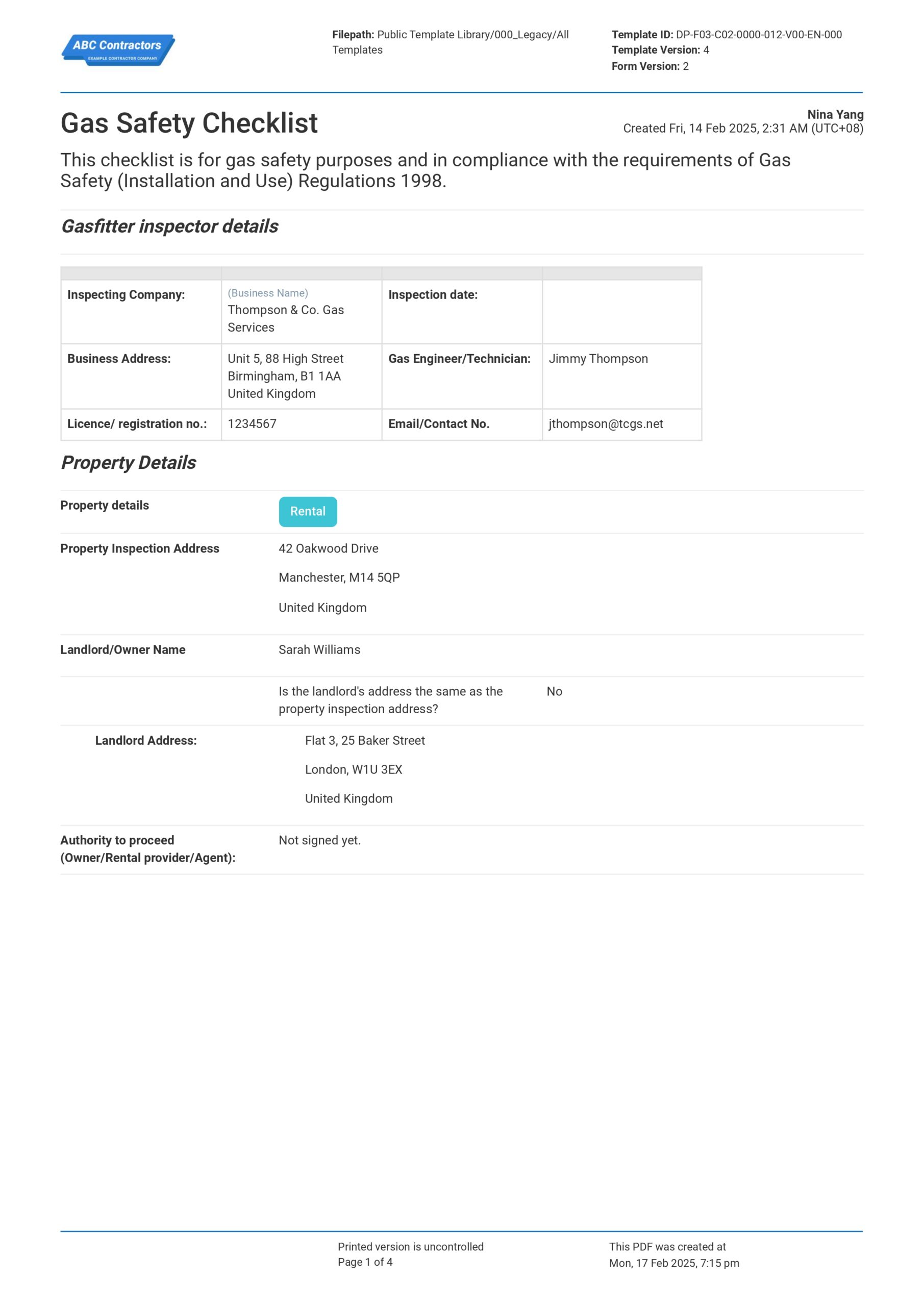
Use this Gas Safety Check structure for yourself
Gas Safety Check requirements
How often is a gas safety check required?
Gas safety check frequency and occurrence will depend on local, state-level or national regulations but it is common for most countries to require gas safety check done annually. Gas safety checks are mandated to landlords or rental property owners, and they must keep the result of gas safety check record in the property to provide to tenants when they move in.
There are even specific regulations on whether the property was vacated for a while and if the property is tenanted it is an offence to have no current gas safety check record in place.
It is important to take note that gas safety checks should only be done by registered gas safe engineers and done to gas appliances that are permanent or portable, but gas safe engineers are not mandated to remind landlords to be in place or up to date.
Gas Safety Check requirements to gas inspectors
Gas safety inspectors are closely monitored and have strict compliances that needs to be followed to be allowed to conduct inspection during installation, repair, and routine servicing of appliances or gas lines in the households, commercial buildings or industrial establishments. Gas safety check companies are required to comply to international standards, building codes, and government regulations & requirements.
Compliance to international standards
What impression does it leave customers when a company is ISO certified? When a gas safe company is International Organization for Standardization (ISO) certified it’s a guarantee that this company is efficient and follows international standards for health and safety. Gas safe companies usually comply to various ISO standards useful for organisations handling inspection.
The following are common ISO standards gas companies should follow:
- ISO/IEC 17020 – these standard issues the requirements for the operation of various types of bodies performing inspection such as gas safety inspectors
- ISO/IEC 17025 – this is for testing and calibration laboratories which is necessary for gas safe companies conducting pressure testing of gas line or pipeline when inspecting if there’s leak or to check tightness
- ISO/IEC 17065 – this is a set of requirements for bodies certifying products, processes and services, when gas safe companies are certified on this, it gives degree of confidence to the customers of gas safety check organisations certifications issued are competent and not impartial
- ISO 9001 – this is an internationally recognised standard for quality management systems (QMS) which essentially helps gas safe companies meet customer and regulatory requirements
- ISO 45001 - an international standard for occupational health and safety management systems that help organizations comply with health and safety laws
Gas Safe Check companies: Compliance and Regulations
Regulations in each country can vary but, in most countries, their requirements are similar in terms of:
- training and competence of gas engineers and technicians from gas inspection companies
- specifics on the installation of pipework’s location and
- check items in gas inspection since gas line systems are similar
Gas Safety Engineers competence and training
The gas safety engineers or technicians are legally required to be competent to conduct inspection. By competent this means the engineer or technician has the educational background or has completed an industry recognised training course and was assessed to qualify their competence in safe installation, testing and maintenance of gas appliances and pipework.
These exams typically involve questions about legislation about gas safety, how to inspect gas appliances, chimney standards, tightness and purging of appliances and many relevant trainings. Below are what your gas safety engineers need to know:
Gas Safety Engineers must have legislation knowledge
Gas safety engineers need to know the national or state-level legislation regarding gas safety to ensure installation and use of gas lines comply to the latest changes in legislation as gas leaks and problems affect not only the people within the establishment but the public’s safety.
Usually, the latest legislations are also changed according to recent findings from other regions and was done to incorporate nationwide or statewide industry safety ensuring consistency in best practices. If you’re managing a team of gas safe engineers, or a gas safe engineer yourself you need to be always updated with the latest changes in the legislation and must ensure that you carry out work within the registered competency. This will also be included in your next qualifying exam.
Gas Safety Engineers must have technical knowledge
As only qualified engineer with a specific competency are allowed to work on specific gas system, it is necessary for gas companies to monitor the competencies. This will depend on what is the expertise or competency the engineers are registered or licensed to handle and determine the team’s capacity specific to the gas safety concern.
In some countries, these competencies might not need a certification, but in other countries like in the UK, or Australia they have equivalent certifications and registration. Depending on your plan, the gas safety engineers have the following example competencies that they need to pass like domestic gas safety, appliance gas safety, LPG, or Commercial Catering (COMCAT)
There are organisations such as Gas Safe in the UK that has an official list of gas engineers who are qualified to work legally in an area and residents or businesses can inquire who are the available and registered engineers within their area that can do the job.
The challenge for gas companies is to ensure the team are always on that list or similar licensing body and are compliant in terms of training. With this, it is necessary to have a monitoring of the competencies of engineer/technicians/fitters necessary. Have a training record and qualifications monitoring document prepared to ensure licenses are renewed and complied.
How to optimise your gas safety check management
All things considered, gas safety check inspection is a critical and important work and if you’re managing a team of inspectors or a gas safety engineer yourself, we want to walk you through some recommendations on how to optimise your gas safety inspection and management:
Impose trainings for soft skills
Apart from the qualifying assessments of gas safety engineers, strive to ensure they are also equipped with soft skills like:
- Communication for when explaining safety concerns with technical and non-technical customers, or to learn to communicate better because they will enter other people’s residents
- Adaptability to changing legislations as they are regularly updated, and it requires them to be trained again as needed to keep their licenses
- Problem solving and decision-making skills of gas safe engineers should be intact and advancing as the work requires not only the head knowledge of what to do and how to do it but when safety issues arises or when diagnosing faults in gas system, they need to have the skill to analyse the symptoms and identify the root cause and decide what actions to undertake.
Implement safety measures for your gas safe engineers or technicians
As much as we need the gas safe engineers to be equipped with local building rules and national regulations to keep the residential and commercial building safe when installing gas lines, we also need to ensure they are safe when doing inspections and checking. Safety measures such as providing them with good fitting personal protective equipment, conducting thorough hazard identification and risk assessment for the job steps they follow depending on their competency, good understanding of fire prevention measures for the tools and operation they do during gas inspection. Implementing safety measures also boost confidence when doing important gas safe work.
Utilise a gas safety check management software
Utilise a gas safety check software to conduct record keeping and gas safety check tracking. Improve inspections by creating gas safety checklist using an app that will allow you to drag and drop sections and add texts, tables, sketches and capture photo or video depending on your needs and preference.
By adapting digital solutions it will enable you to trace documentation using a cloud-base software and you will have the option to organise everything in a timeline, workflow or register view because of the software’s document management features. This also enables you to be ISO standard certified because the software features a good and centralised record controlling system.
In Summary
This article was a guide to what is gas safety check and what does gas safety check involve on the standpoint of a gas safety check professional which covers: location or site assessment, safety precautions for gas appliances and design or tubing of pipes requirements and gas safety check records. Considering how critical gas safety checks are, we also included the gas safety check requirements that companies must comply and that is it must be ISO certified, must comply to local building codes and national regulations which includes ensuring gas engineers are licensed, qualified and trained with latest legislations and the right technical knowledge depending on competency.
Lastly, we went through how to optimise the management of gas safety inspections by (1) starting with ensuring gas safe engineers are also trained with soft skills, (2) safety measures are implemented for their sake and (3) adapting digital solutions by utilising a gas safety management software for the compliance and convenience of record keeping and traceability.

Hot works permit
Make sure any hot works are safe and compliant
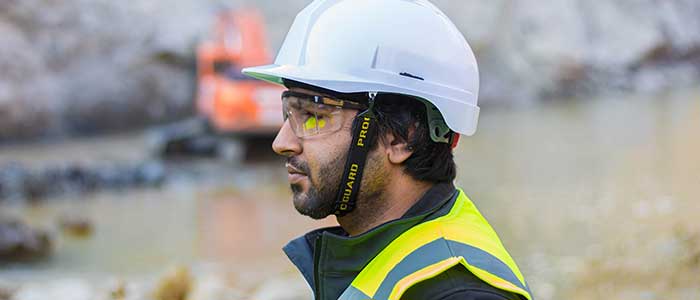
Take 5
Streamline how your team document and share Take 5s
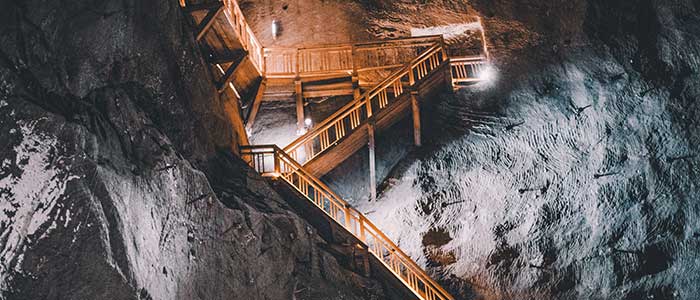
Safety audit checklist
Conduct compliant safety audits using this form framework

